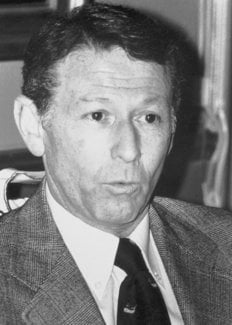Paul Berg
Biographical

I was born in New York on June 30, 1926 and my formative years were spent in a small, gated community named Sea Gate, at the southernmost tip of Brooklyn. By the time I reached Jr. high school I had already formed a strong ambition to be a scientist, in part stimulated by my readings about medical scientists: “Arrowsmith” by Sinclair Lewis and “Microbe Hunters” by Paul DeKruif. An inspiring high school “teacher”, Sophie Wolfe, whose job was to supervise the stockroom that supplied the classes in chemistry, physics and biology, nurtured that ambition. Her love of young people and interest in science led her to start an after school program of science clubs. Rather than answering questions we asked, she encouraged us to seek solutions for ourselves, which most often turned into mini research projects. Sometimes that involved experiments in the small lab she kept but sometimes it meant going to the library to find the answers. The satisfaction derived from solving a problem with an experiment was a very heady experience, almost addicting. Looking back, I realize that nurturing curiosity and the instinct to seek solutions are perhaps the most important contributions education can make. With time, many of the facts I learned were forgotten but I never lost the excitement of discovery.
I graduated from high school (1943) just a year after the bombing of Pearl Harbor and enrolled at New York’s City College to study chemical engineering. But the prospects of designing chemical plants for industrial scale chemical processes seemed far less interesting than the chemical events that occur in biological systems. But I felt it necessary to be part of the war effort and I enlisted in the Navy to be a flyer. While waiting to be called to pre-flight training, I enrolled at the Pennsylvania State University to study biochemistry. After a few months I was called to active duty but allowed to remain at Penn State for pre-flight training. After a year at Penn State and six months training at sea I served on a submarine chaser through the end of the war. I returned to the university in the fall of 1946 and completed my undergraduate degree in biochemistry two years later.
As a project during the senior year, I studied a group of papers that dealt with the application of newly available radioisotopes as tracers for the study of intermediary metabolism. Particularly fascinating were a succession of papers from Western Reserve University that showed how compounds labeled with isotopic carbon and/or heavy nitrogen atoms could be tracked during their conversion from foodstuffs to cellular materials. That seemed exciting and although I had never heard of Western Reserve University it was my next destination.
That was a fortunate choice; in fact, it changed the course of my career. Because of its pioneering work in this new field, the department had by the late 1940’s become one of the important biochemistry centers in the country. Harland Wood, the department head, was an inspiring scientist and teacher but he was also devoted to his students and colleagues. My doctoral thesis concerned what is today referred to as C1 metabolism, more specifically the conversion of formic acid, formaldehyde and methanol to the fully reduced state of methyl groups in methionine. I was among the first to demonstrate, in vitro, that folic acid and vitamin B12 cofactors participated in these processes. (1952). By that time I was hooked on a career in academic research instead of one in the pharmaceutical industry that I had originally considered in deciding to get a PhD.
Seeking more experience with enzymes, I studied for a year in Copenhagen with Herman Kalckar at the Institute of Cytophysiology and for a second year with Arthur Kornberg at Washington University in St. Louis. Both were very productive and enjoyable experiences. In Copenhagen, Wolfgang Joklik and I discovered a new enzyme that created the nucleoside triphospates for nucleic acid assembly and the next year in Kornberg’s lab, I discovered a previously unknown class of biological compounds – acyl adenylates – intermediates in the formation of fatty acyl-CoAs from fatty acids, ATP and CoA. This type of reaction, I discovered, was also central to the way amino acids are activated as amino-acyl adenylates prior to being linked to tRNAs. By then, I was making the slow transition from classical biochemistry to molecular biology and becoming increasingly preoccupied with how genes act and how proteins are made.
After 6 years in St. Louis, I moved to Stanford University’s Medical Center (1959) to help Kornberg set up the new department of biochemistry. In time, my interests shifted from studies with microorganisms to mammalian cells and I spent a year experimenting with Polyoma and SV40 tumor viruses in mammalian cell culture with Renato Dulbecco at the Salk Institute. Soon after I returned to Stanford, I conceived of using SV40 as a means for introducing new genes into mammalian cells much in the way that bacteriophage transduce cellular DNA among infected cells. My colleagues and I succeeded in developing a general way to join two DNAs together in vitro; in this case, a set of three genes responsible for metabolizing galactose in the bacterium E. coli was inserted into the SV40 DNA genome. That work led to the emergence of the recombinant DNA technology thereby providing a major tool for analyzing mammalian gene structure and function and formed the basis for me receiving the 1980 Nobel Prize in Chemistry.
* This autobiography was provided by the Laureate in March 2004.
Paul Berg died on 15 February 2023.
Copyright © The Nobel Foundation 2004Nobel Prizes and laureates
Six prizes were awarded for achievements that have conferred the greatest benefit to humankind. The 12 laureates' work and discoveries range from proteins' structures and machine learning to fighting for a world free of nuclear weapons.
See them all presented here.
